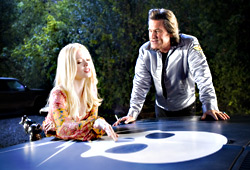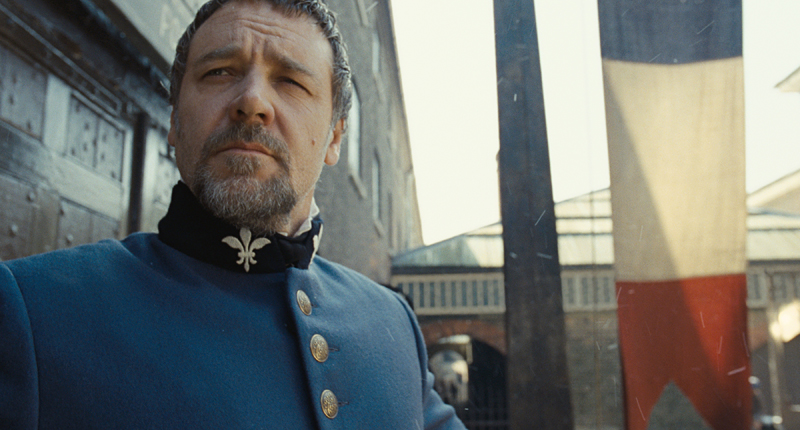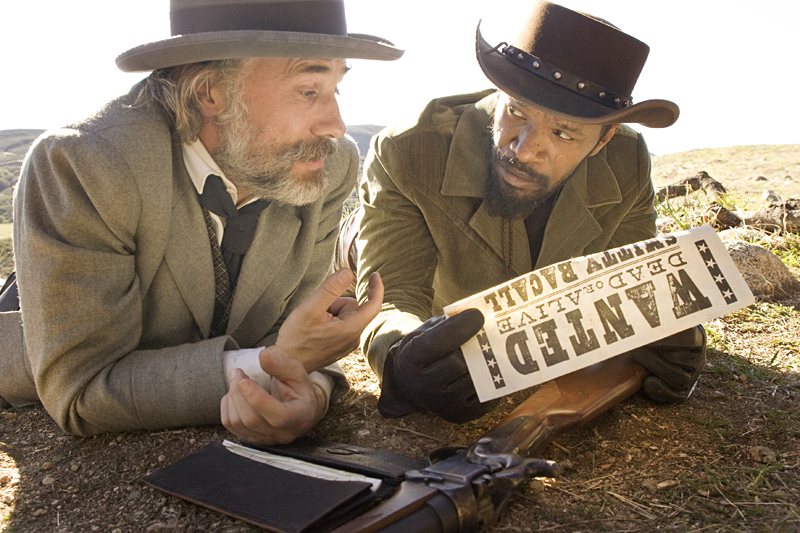There is some debate about audience familiarity with the term “grindhouse,” and even a certain confusion about the origins of the word itself–whether it refers to the movies that comprised a gilded age of exploitation cinema or to the all-night urban theaters in which they were regularly shown. It matters little, though, for so richly evocative is Quentin Tarantino and Robert Rodriguez’s Grindhouse of an earlier generation’s guilty cinematic pleasures that you can practically feel the stick of dried soda under your sneakers and smell the faint aroma of bum emanating from the row behind you. Yet, Grindhouse is ultimately less about a fixed time or place than about a state of mind—a democracy of cinephilia in which a well-executed blow job or beheading can be, in its way, as thrilling as a David Lean landscape or an Eisensteinian montage.
Tarantino and Rodriguez are telling us something about what turned them on at the movies back when the thrills were as cheap as the tickets (and before Hollywood started making steroidal versions of grindhouse movies with A-list stars and nine-figure budgets), and for the like-minded, this three-hour double-header will prove as potent a head trip as Proust’s madeleine. For the rest, it may seem like nothing more than a supersized bag of stale popcorn. Indeed, the greatest failing of Grindhouse is simply that there are no longer any proper grindhouses in which to screen it, though both directors have gone out of their way to guarantee viewers a decidedly THX-uncertified viewing experience. Built into the body of both movies are print scratches, missing scenes, bad splices, and projection malfunctions—deliberate “mistakes” that serve as a melancholic epitaph not just for the grindhouses but for the soon-to-be-extinct phenomenon of movies shot and projected on 35 mm film. Some highly impressive CGI notwithstanding, the joys of Grindhouse are distinctly of the analog variety.
Often, though, the problem with movies made in such a conscious state of nostalgia is that they have a tendency to anesthetize the elemental appeal of the objects of their nostalgia (Down With Love, anyone?). But any such fears about Grindhouse are quickly obliterated (along with just about every living thing on screen) by Rodriguez’s Planet Terror, a 90-minute jolt of zombie mayhem that suggests the mutant offspring of George Romero’s The Crazies and John Carpenter’s Assault on Precinct 13 (which, in this critic’s book, is like manna from grindhouse heaven). The movie begins with a bang—or maybe it’s a bing—as the dexterous go-go dancer Cherry Darling (Rose McGowan) shows her love for a shiny metal pole in a down-market Texas nightclub. Cut to a roadside barbecue joint where Cherry is unexpectedly reunited with El Wray (Freddy Rodriguez), the mysterious loner-drifter with whom she shares an unspoken past. Planet Terror doesn’t have much time for explanations, though, for by this point a flesh-eating (and reanimating) chemical weapon is already making its way through the night air, creating a zombie army in its wake and leaving Cherry, Wray, and a scrappy band of other uninfected survivors as mankind’s last, best hope for survival.
With the trifecta of 28 Days Later, Land of the Dead, and Joe Dante’s made-for-television Homecoming (to name just three), the past few years have turned out to be the salad days for the zombie movie, in no small part because the genre lends itself so well to metaphors for groupthink, class inequality, and the loss of civil liberties. If Planet Terror isn’t quite as sharp as those others in its sociopolitical musings (despite a cautionary message about unchecked military power), it’s nevertheless carried along by a current of crude energy and gory élan that rarely lets up. Not least among its achievements are the transformation of the diminutive Freddy Rodriguez into a socko action-movie hero, the revelation of Marley Shelton (cast as one of two bickering, married doctors who find themselves working a whole new kind of graveyard shift) as a deft screwball comedian, the recovery of McGowan from the annals of bad television, and—one year on from the tedious nihilism of Sin City—a renewal of the lightness and invention that gave Robert Rodriguez’s Spy Kids movies their infectious kick.
Planet Terror gets the audience worked up into such a frenzy, in fact, that you start to wonder if Tarantino can possibly top it. But as soon as Death Proof gets under way, it becomes clear nothing could be further from Tarantino’s mind. Rather than challenging Rodriguez to a cinematic pissing contest, he mellows the mood with a thoroughly unpredictable road movie in which long, laconic passages of cheerleader-movie-style girl bonding give way to sudden bouts of vehicular manslaughter and an orgiastic tribute to tough, kick-ass babes that could earn its creator lifetime membership in the feminist academy.
Conceived in two distinct, Psycho-like parts separated by what could be considered Tarantino’s shower scene on wheels, the movie follows two groups of female friends—one in Austin, Texas; the other in rural Tennessee—as they successively cross paths with a scar-faced stranger known only as Stuntman Mike (Kurt Russell, reconnecting with his inner tough guy), a former movie stuntman whose roguish charm belies a murderous psycho within. His skull-and-crossbones-decorated Dodge Charger literally knocks the ladies dead. Until, that is, he meets his match in a daredevil New Zealand stuntwoman (real-life stunt player Zoe Bell) on furlough from a film shoot, her three plucky crewmates (the terrific Rosario Dawson, Tracie Thomas, and Mary Elizabeth Winstead), and, oh yes, a 1970 Dodge Challenger identical to the one a deliveryman named Kowalski drove from Colorado to California in the 1971 cult classic Vanishing Point.
This isn’t the first time that Tarantino has showcased his affection for muscle cars and muscular women, or loaded up a screenplay with pop-culture references (the 1960s British Invasion band Dave Dee, Dozy, Beaky, Mick & Tich gets a memorable shout-out) and verbose discussions of not very much. But Death Proof feels especially personal because its main characters aren’t two-bit SoCal crooks or vengeance-minded single moms, but rather the very movie performers and technicians for whom the director clearly feels a special kinship. If all of Tarantino’s films can be said to flow from other movies, Death Proof is the one that most directly addresses his chosen profession, his unapologetic movie fandom, and the lurid power movies can exert on our subconscious. As Tarantino’s film-referencing leading ladies engage Stuntman Mike in an old-school automotive duel that immediately earns a place of honor among the great celluloid car chases, it’s as if they’ve willed their own grindhouse movie into being, and all we can do is hold on to our armrests and pray for someone to yell “Cut!”
For all its automotive derring-do, the most violent collision in Death Proof is the one that occurs between the real and the reel, a metaphysical terrain that Tarantino prowls every bit as boldly as David Lynch did in last year’s Inland Empire (no matter that the two films could scarcely be more different in style and tone). Like Lynch’s movie, I suspect that Death Proof will throw some of its director’s admirers for a loop, though it may be the most revealing thing Tarantino has yet done—a full-throttle expression of a singular artistic temperament disguised, like so many gems of grindhouses yore, as a glittering hunk of trash.








